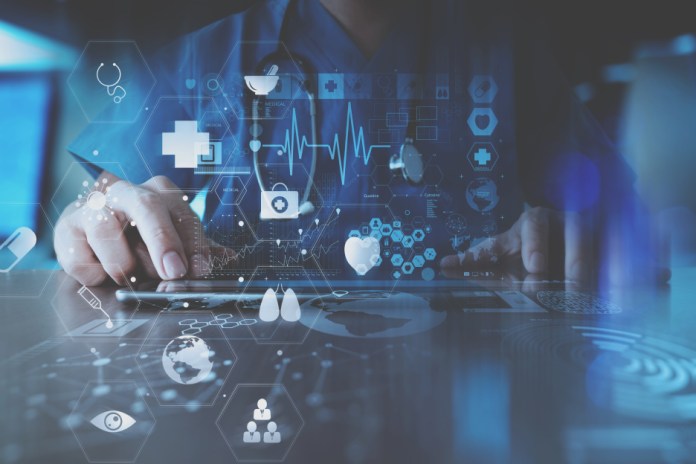
(Source: Shutterstock)
Smart health care entails a lot of connected parts (no pun intended). These include telemedicine services, wearables from fitness trackers to heart and glucose monitors that record and transmit data to connected platforms or electronic medical records, and medical imaging equipment that now uses artificial intelligence to improve diagnostics. In addition, all these connected devices generate lots of data that are being used to improve a patient’s health through prevention and treatment plans.
Certainly, the Covid-19 pandemic had a big hand to play in moving the medical industry into the digital health realm, with patients quickly embracing remote doctor visits and treatments. In fact, consumers are the driving force behind the innovation in digital health-care products, said nine out of 10 survey respondents in Jabil’s 2021 Digital Health Survey report, which surveyed over 200 health-care decision-makers at health-care companies.
So it is no surprise that the top three solutions that health-care providers are developing or are planning to develop center around patient monitoring, diagnostic equipment, and on-body or wearable devices, according to the Jabil report.
This month’s issue takes a look at some of the developments happening in smart health care. Clearly, the demand for remote patient monitoring is on the rise to help improve patient care and to reduce health-care costs. Connecting people to their health and encouraging behavioral change is also a big driver behind technology advances by health-care product manufacturers.
By tracking a patient’s health for chronic diseases such as cardiovascular, hypertension, diabetes, and respiratory via monitoring devices, RPM can alert doctors to early warning signs that enable them to take action, reducing emergency room visits and hospitalizations. RPM can also lower health-care costs for some of the same reasons, as well as reduce the need for patients to be physically at a medical facility.
Even if it’s not possible to keep people out of the hospital, health-care product manufacturers are developing diagnostic equipment that uses the latest technologies to improve imaging, portability, and operational savings. Sally Ward-Foxton, editor-in-chief of EE Times Weekend and AspenCore’s AI expert, tells us that the latest developments in AI hardware and software are revolutionizing medical device development, wherein the technology is now widely used to process, predict, and visualize medical data in real time.
Ward-Foxton recently spoke with Nvidia Corp.’s vice president of health care, Kimberly Powell, who told her, “The fact that we can now put artificial intelligence in instruments [means] magic starts to happen.”
AI is also revolutionizing surgery, especially for modern, minimally invasive surgery techniques in which the surgeon has only a camera view into the body, said Powell. She also discusses three key limitations on using AI in medical devices today and gives us a glimpse into Nvidia’s progress in these areas.
At the same time, there is a lot of innovation happening in the medical wearables market. Medical- and consumer-grade wearable devices continue to enhance connectivity and battery life to enable real-time and noninvasive monitoring of multiple biomarkers like blood pressure, temperature, and body hydration, reported Majeed Ahmad, editor-in-chief of EDN.
But that’s not all. These next-generation wearables as diagnostic and monitoring devices are taking the health-care industry from reactive to proactive by adding AI and cloud analytics to facilitate a holistic assessment of various conditions, said Ahmad. Most of these wearable devices are hooked into the internet-of-things systems, he said, and thus can facilitate medical treatment from the patient’s own home.
Advances are also being made at the component level. Over the past few years, for example, we’ve seen the development of imaging subsystems and camera modules that help medical OEMs speed up their time to market while enabling them to focus on differentiating their product designs. Some of those advances are related to the medical industry’s move from reusable to disposable endoscopes.
In addition to the need for improving diagnostic accuracy, which requires high image quality, these image sensor solutions also need to shrink for the disposable endoscope market. At the same time, image sensor manufacturers also need to address issues around design complexity and integration. To address these concerns, a few image sensor manufacturers have developed integrated imaging subsystems along with smaller camera modules that make it a lot easier to integrate into these endoscopes.
We also cover AC/DC power supplies for medical and industrial applications. The latest power devices for these applications share a couple of things in common: They offer a smaller solution size and achieve a higher power density while providing higher efficiency. You’ll also find that many power supply manufacturers are rolling out flexible and more options to meet the wide range of medical and industrial applications.
Don’t miss the top 10 power management ICs. “It is not uncommon today to see applications that require 10 or more different power rails,” said contributing writer Stefano Lovati. “PMICs allow you to effectively and efficiently solve the problem of multiple power supplies, simplifying the project and reducing the application’s time to market.”
Lovati looks at 10 of the best PMICs available on the market for applications including consumer electronics, wearables, industrial sensors and actuators, IoT, and automotive.
Advertisement





